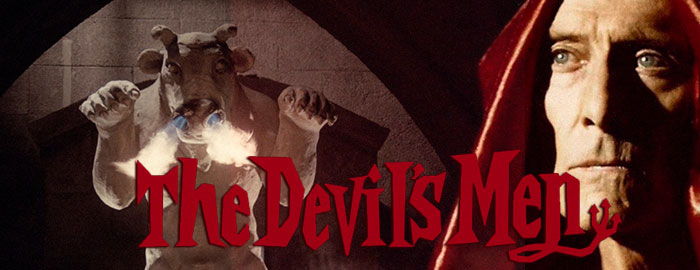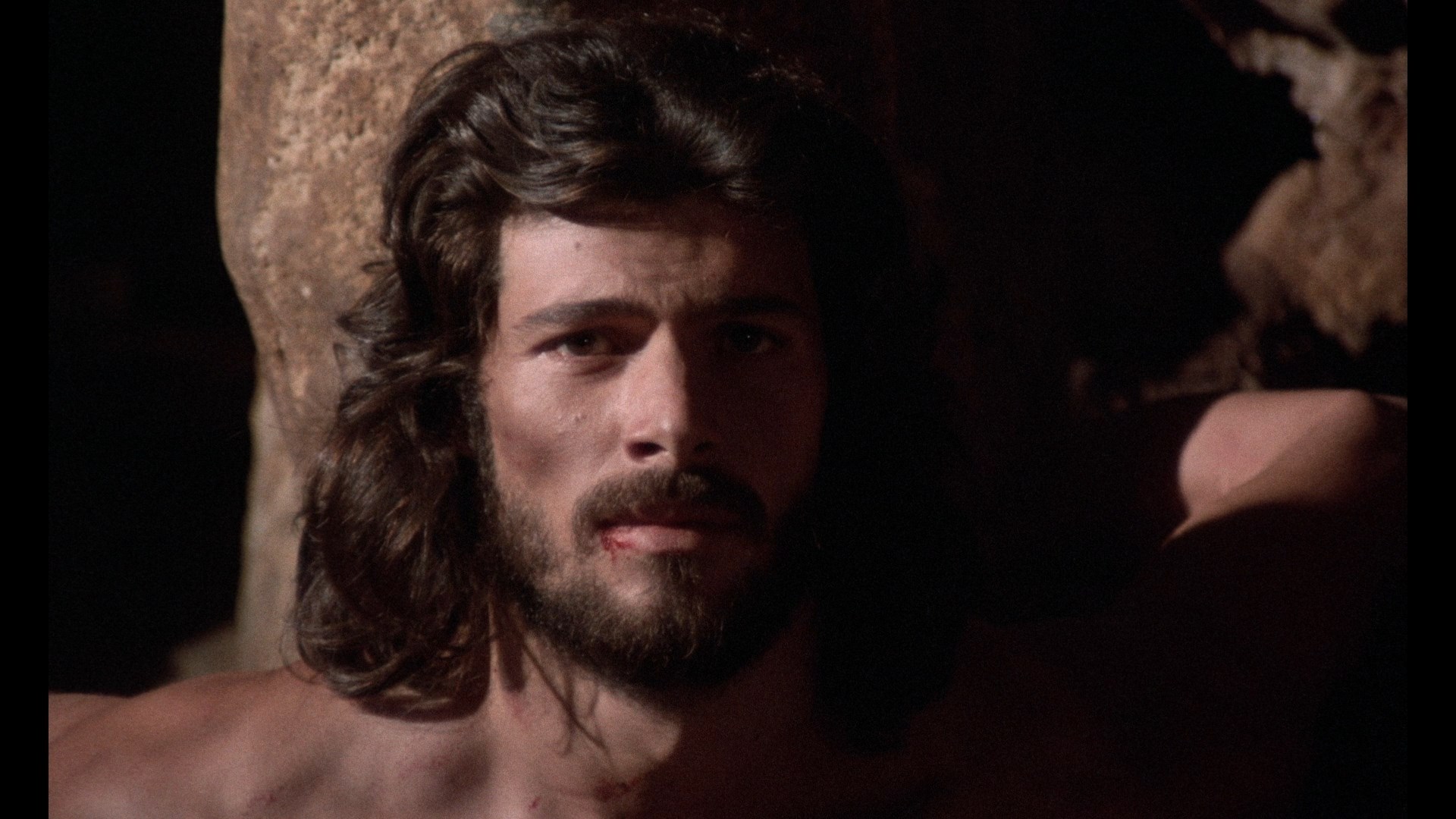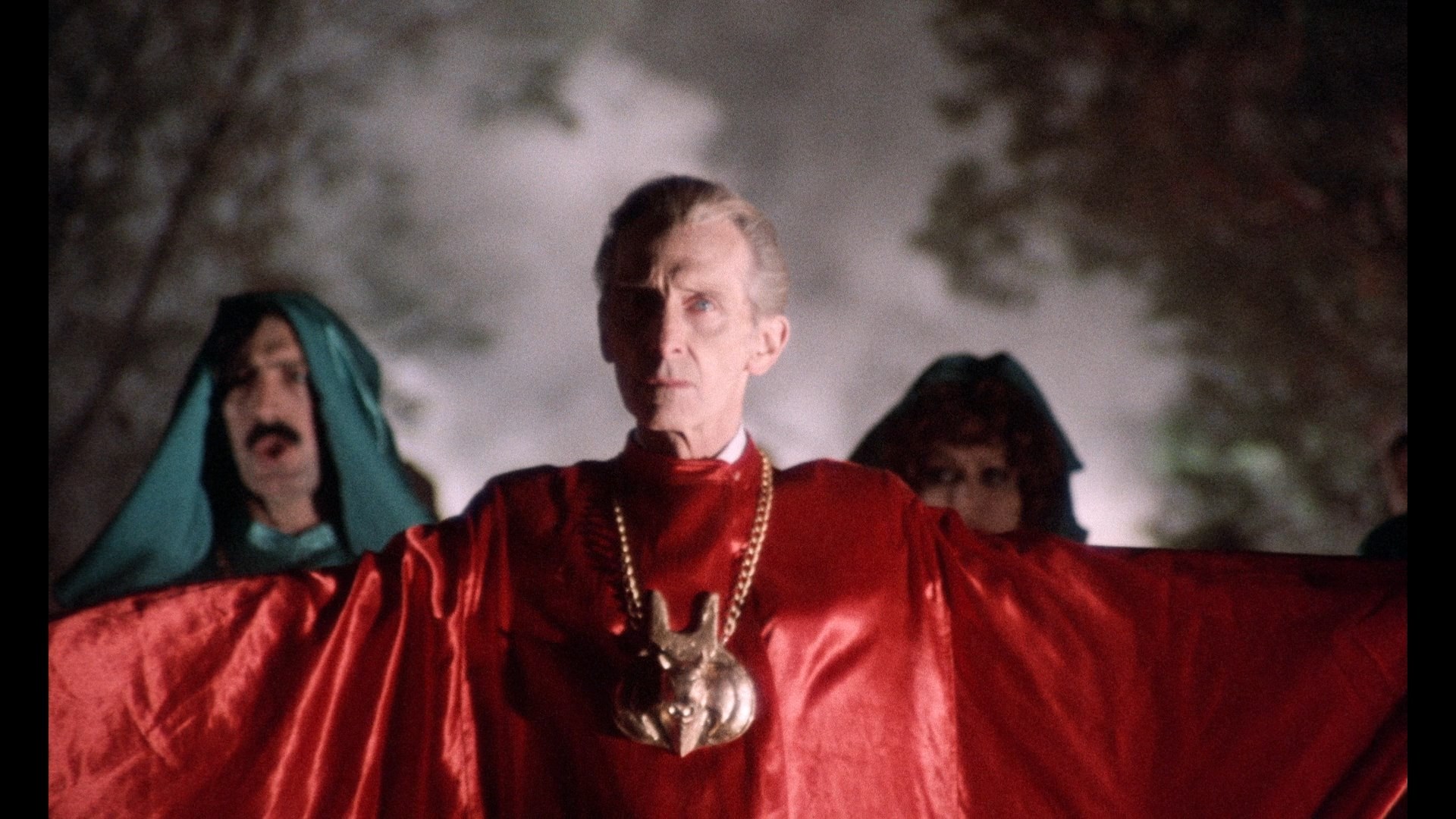

Color, 1976, 94 mins. 24 secs. / 85 mins. 41 secs.
Directed by Costas Karagiannis
Starring Peter Cushing, Donald Pleasence, Cortas Skouras, Luan Peters
Indicator (Blu-ray) (US/UK R0 HD), Scorpion Releasing (DVD) (US R0 NTSC), Odeon (UK R0 PAL) / WS (1.66:1) (16:9), BCI (US R1 NTSC) / WS (1.78:1) (16:9), Simply Meda (UK R2 PAL) (1.85:1)
 some combination of the three; no exception to this rule is the oddball Greek shocker, The Devil's Men (released in the U.S. in
some combination of the three; no exception to this rule is the oddball Greek shocker, The Devil's Men (released in the U.S. in  theaters and on home video from Crown International in truncated PG-rated form as Land of the Minotaur, which pits the latter two actors against each other in a barely disguised knockoff of The Devil Rides Out spiced up by its unusually scenic locations.
theaters and on home video from Crown International in truncated PG-rated form as Land of the Minotaur, which pits the latter two actors against each other in a barely disguised knockoff of The Devil Rides Out spiced up by its unusually scenic locations.  American DVD debut as Land of the Minotaur when presented by BCI in its shorter Crown cut, widescreen and anamorphically enhanced. The transfer seems to be
American DVD debut as Land of the Minotaur when presented by BCI in its shorter Crown cut, widescreen and anamorphically enhanced. The transfer seems to be  taken from an okay print, though the contrast is a bit harsh and print damage is evident throughout with incredibly awful audio to boot. A subsequent UK standalone release followed from Odeon as well as a pairing with Blood Mania from Code Red (squished out from 1.66:1 to 1.78:1 with squashed-looking actor faces), but a better option came with the double feature from Scorpion on DVD co-billed with a significantly more flamboyant title, the madcap witch romp Terror (another Crown release), directed by Norman J. Warren (Satan's Slave), which has since been reissued from Indicator and Vinegar Syndrome. The Scorpion improves right out of the gate with an uncut, anamorphic transfer of The Devil's Men correctly framed at 1.66:1. The film still isn't much of a visual dazzler, but the improvement is obvious and the extra little helpings of topless nudity and bloodshed help make it a much more lively experience than the TV-friendly slog most Americans had to endure for decades. No real extras per se on that first film, but both titles are bookended with hosting sequences (and an intermission in between) featuring horror hostess Katarina Leigh Waters, which makes sense as this is part of her "Katarina's Nightmare Theater" line. Once again she's on her most comfortable turf here talking about British '70s horror (or in one case, British-Greek hybrid horror), and her enthusiasm makes for pleasant viewing.
taken from an okay print, though the contrast is a bit harsh and print damage is evident throughout with incredibly awful audio to boot. A subsequent UK standalone release followed from Odeon as well as a pairing with Blood Mania from Code Red (squished out from 1.66:1 to 1.78:1 with squashed-looking actor faces), but a better option came with the double feature from Scorpion on DVD co-billed with a significantly more flamboyant title, the madcap witch romp Terror (another Crown release), directed by Norman J. Warren (Satan's Slave), which has since been reissued from Indicator and Vinegar Syndrome. The Scorpion improves right out of the gate with an uncut, anamorphic transfer of The Devil's Men correctly framed at 1.66:1. The film still isn't much of a visual dazzler, but the improvement is obvious and the extra little helpings of topless nudity and bloodshed help make it a much more lively experience than the TV-friendly slog most Americans had to endure for decades. No real extras per se on that first film, but both titles are bookended with hosting sequences (and an intermission in between) featuring horror hostess Katarina Leigh Waters, which makes sense as this is part of her "Katarina's Nightmare Theater" line. Once again she's on her most comfortable turf here talking about British '70s horror (or in one case, British-Greek hybrid horror), and her enthusiasm makes for pleasant viewing.  past releases, far superior contrast and detail, and more convincing color timing. It also
past releases, far superior contrast and detail, and more convincing color timing. It also  sounds a lot better, too, with a solid DTS-HD MA English 1.0 track (with optional English SDH subtitles). A very informative and sometimes quite amusing new audio commentary by critics and authors David Flint and Adrian J. Smith goes a thorough job of covering the film including its odd financing (a combination of U.S. money and, believe it or not, the famous Getty family in America), the state of international horror filmmaking at the time, the release history and alternate versions, the careers of Pleasence (including his odd Irish accent) and Cushing whose roles were originally supposed to be swapped, the joys of watching Cushing brandish a shotgun, and more. Also playable with the film is "The John Player Lecture with Peter Cushing," a 92-minute audio recording of a discussion with the actor and David Castell at London's National Film Theatre. It's very witty and packed with stories of his career starting with his early inspiration from Tom Mix movies through his progression to becoming a performer on the big and small screens in Great Britain including Hammer and beyond, as well as sojourns with Hollywood stars. In "This Life and the Next" (7m48s), producer Frixos Constantine looks back at the film including director Costas Karagiannis, the script, the decision to hire Eno, and the cast (some of whom were more pleasant than others); his accent is very thick which makes a few bits hard to make out, but it's worth a listen. Also included is the sanitized Super 8 version (93m20s) which still runs a lot longer than the American one, plus a Land of the Minotaur TV spot and trailer promoting this as "the most terrifying film of 1977" (which will come as a surprise to The Hills Have Eyes, Suspiria, Rabid, Shock, Rituals...). Finally the disc rounds out with a 29-image gallery of international photos and poster art (including a couple of shots not in the actual film), while the insert booklet features a new essay by Andrew Graves, an archival interview with Pleasence, highlights from the PR campaign, and critical reactions.
sounds a lot better, too, with a solid DTS-HD MA English 1.0 track (with optional English SDH subtitles). A very informative and sometimes quite amusing new audio commentary by critics and authors David Flint and Adrian J. Smith goes a thorough job of covering the film including its odd financing (a combination of U.S. money and, believe it or not, the famous Getty family in America), the state of international horror filmmaking at the time, the release history and alternate versions, the careers of Pleasence (including his odd Irish accent) and Cushing whose roles were originally supposed to be swapped, the joys of watching Cushing brandish a shotgun, and more. Also playable with the film is "The John Player Lecture with Peter Cushing," a 92-minute audio recording of a discussion with the actor and David Castell at London's National Film Theatre. It's very witty and packed with stories of his career starting with his early inspiration from Tom Mix movies through his progression to becoming a performer on the big and small screens in Great Britain including Hammer and beyond, as well as sojourns with Hollywood stars. In "This Life and the Next" (7m48s), producer Frixos Constantine looks back at the film including director Costas Karagiannis, the script, the decision to hire Eno, and the cast (some of whom were more pleasant than others); his accent is very thick which makes a few bits hard to make out, but it's worth a listen. Also included is the sanitized Super 8 version (93m20s) which still runs a lot longer than the American one, plus a Land of the Minotaur TV spot and trailer promoting this as "the most terrifying film of 1977" (which will come as a surprise to The Hills Have Eyes, Suspiria, Rabid, Shock, Rituals...). Finally the disc rounds out with a 29-image gallery of international photos and poster art (including a couple of shots not in the actual film), while the insert booklet features a new essay by Andrew Graves, an archival interview with Pleasence, highlights from the PR campaign, and critical reactions.![]()